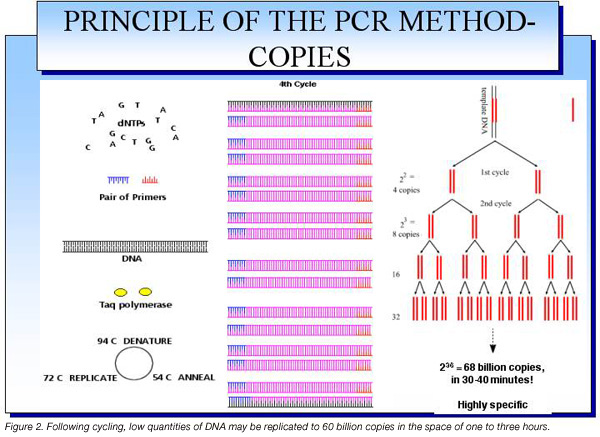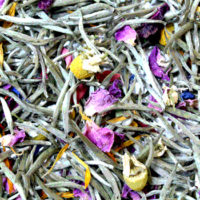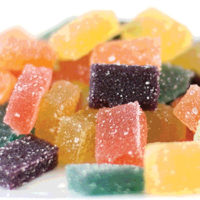Although much progress has been made in reducing the level of microbial pathogens in our food supply, the risk of contamination can be expected to continue. Multiple responses to this risk have been implemented, including Hazard Analysis & Critical Control Points (HACCP), improved sanitation programs and increased testing. Although testing by itself would be a flawed strategy, it does have a place in a larger program of enhancing food safety. Unfortunately, microbial testing continues to have limitations. No single method provides results in real time. Many of the methods remain tedious to perform. False negatives and false positives remain a concern. Microbiologists are solving these problems, but progress is step-wise over time.
The DNA-based methods such as polymerase chain reaction (PCR) appear to offer good potential in advancing the technology of rapid microbial detection. PCR offers high specificity and accuracy with improved sensitivity. PCR is gradually gaining acceptance as a quality assurance tool in the food industry. This article will detail the position of PCR in the food industry with reference to current methods, a simple overview of the technique, the availability of rapid and automated PCR methods, and the future and benefits to the food industry.
THE “IDEAL” TEST
For those interested in detecting pathogen and spoilage organisms, it will come as no surprise that an ideal rapid microbiology test does not yet exist. Such an ideal test would provide an “instant” result, would be easy to use and require minimal operator skills, be applicable to all samples and food types, provide totally accurate data with no false positives or false negatives, and be easy to validate. It should also offer a full range of parameter (organisms), such as E. coli, Salmonella and Listeria, in one instrument at a low cost per test. In the past 10 years, significant progress has been made in the development of rapid tests in many of these areas.
There have been great improvements in many of the traditional microbiological methods used to detect foodborne pathogens and spoilage organisms. Some of the more classical approaches that have been incorporated into rapid methods include selective media for pH, inhibitors, antibiotics, incubation temperature and atmosphere; indicator media for acid production, chromagens, gas production, liquification and motility; immunoassays; and detection methods ranging from conductance/impedance, dye absorption and image analysis, to microcalorimetry. Although no single method is suitable for every company’s applications, the molecular methods, such as PCR, offer a lot of promise, primarily because these techniques offer advantages in better specificity.
.jpg) The polymerase chain reaction was first described in 1985, but in the last few years, the method has begun to be considered as a useful tool for the quality assurance (QA) laboratory. The current PCR method entails the (1) separation of the DNA molecule into its two strands, (2) the annealing of short DNA fragments, or primers, on their specific sequences, (3) elongation of these short fragments by Taq-Polymerase, (4) cycling or repetition of steps 1 through 3, and (5) detection by specific probes (Figure 1). Following cycling, low quantities of DNA may be replicated to 60 billion copies in the space of one to three hours (Figure 2). This resulting specificity is only as good as the primer-probe combination developed for the test, and this is one of the key unspoken issues in the use of PCR.
The polymerase chain reaction was first described in 1985, but in the last few years, the method has begun to be considered as a useful tool for the quality assurance (QA) laboratory. The current PCR method entails the (1) separation of the DNA molecule into its two strands, (2) the annealing of short DNA fragments, or primers, on their specific sequences, (3) elongation of these short fragments by Taq-Polymerase, (4) cycling or repetition of steps 1 through 3, and (5) detection by specific probes (Figure 1). Following cycling, low quantities of DNA may be replicated to 60 billion copies in the space of one to three hours (Figure 2). This resulting specificity is only as good as the primer-probe combination developed for the test, and this is one of the key unspoken issues in the use of PCR.

The analytical basis for laboratory use of PCR involves several steps, beginning with enrichment. However, the enrichment steps do not have to incorporate the classical steps of selective enrichment. Non-selective enrichment can be used to very suitable effect within 24 hours. In foods, sample preparation is a critical aspect of this step-by-step process, but it is only relatively recently that much attention has been given to this part of the analysis. If a dilution is used in this step, one needs to be careful that the initial DNA copy number is high enough to withstand the losses of dilution (potentially leading to a false negative). The purification or sample preparation step as a whole typically takes about one hour to perform, depending on the number of samples.
The DNA amplification step (during thermocycling) and the specific DNA detection step have been combined by many PCR system manufacturers into one step. The need for gels in the “old” polymerase chain reaction detection method has been replaced by the use of fluorescence resonance energy transfer (FRET). While enzyme-linked immunosorbent assay (ELISA) also can be a PCR detection method, the “on-line” PCR detection systems that have been developed to achieve real-time food pathogen detection utilize FRET.
There are two modifications of FRET, the most commonly used consisting of probes with fluorochromes and quenching agents. When the DNA target is present and a quenching agent linked to the probe is released, a dye or fluorochrome on the probe may be excited and detected with fluorescence. DuPont Qualicon (BAX), Cepheid (Smart Cycler), Applied BioSystems (PRISM) and BioRad (ICycler) use this kind of FRET, although not all of these systems are real-time. The second type of FRET is more direct. The presence of two probes and fluorochromes on the target DNA allows the transfer of energy from one fluorochrome to another with subsequent detection of fluorescence at another wavelength. Companies using this type of FRET include Roche/Biotecon Diagnostics (LightCycler) and Idaho Technologies.
SYSTEM CONSIDERATIONS
The common features among real-time PCR systems (instruments, reagents and methods) include enrichment times of 20 hours or longer, sample preparation in 30 to 60 minutes, reagents supplied in kit form, PC-controlled systems, internal positive/negative controls, with reagents and instruments for combined amplification and detection. When a new user looks at different PCR methods—and other rapid methods in microbiology— one of the problems that becomes apparent is the difficulty in choosing a system that is right for a particular food manufacturing operation. All systems may yield a result and may do so more quickly and easily than five years ago.
However, understanding the differences among the current real-time PCR systems becomes an important decision- making factor. Such differences include:
• The range of available tests vary. Depending on the type of test, the sample preparation may vary, as well, and affect the ultimate decision on which system is optimal with a given set of needs.
• AOAC International approvals. Validation of the PCR system is important, and PCR companies that undergo the AOAC Official Action or Research Institute (RI) process can provide relevant data to a potential user with regard to whether the system is suitable for a particular application. It is also more likely that the manufacturer actually understands the application of his/her product in the real world. New products that have not undergone AOAC International work may be more susceptible to this potential problem than older systems already in use in food companies.
• Sensitivity and accuracy. Sensitivity is closely tied to sample preparation and enrichment procedures, for example, and a potential user should consider carefully the types of sample prep and enrichment the system requires to aid in any PCR decision.
• Assay times vary from between one and three hours. A PCR system that utilizes capillary tubes, such as the Roche LightCycler, typically takes an hour for amplification/detection. In contrast, other systems using microtiter plates or tubes have some reduced handling, but require up to three hours for results during amplification.
• Software. Ease of use of software also is important to the selection process. The level of system dedication to the food industry, such as the DuPont Qualicon BAX, is sometimes a clue to good software.
• Reagent composition. One needs to consider whether lyophilization benefits the user or the manufacturer. Assuming adequate shelf life, use of a liquid product can mean one less preparation step. Most manufacturers are now adding Uracil-N-Glycosylase (UNG) to kits to destroy contaminating DNA made in earlier PCR runs. Look for UNG-containing kits that do not require any intervention (steps) on the part of the user.
• Level of system dedication. Is this a dedicated system, or is it better applied as a research and development (R&D) tool? Some of the real-time PCR systems, like the Icycler, LightCycler and PRISM have uses beyond those of the QA application. If R&D is part of the user’s capabilities and goals, these systems serve double duty and give added value for the investment made. Alternatively, the same capability for double duty may be wasteful if never used.
• Melting curves. A 20-minute denaturation of the DNA molecule at the end of amplification and detection allows sub-species analyses to be conducted. This is by no means comparable to serotyping, but it does give new information, previously unavailable in PCR The more direct form of FRET may produce more distinctive melting curves. A quick look at melting curves of the different systems shows the differences.
• FRET as the basis for detection. As discussed, there are two modifications of FRET employed in real-time PCR systems. Both work well in foodborne pathogen analysis.
• Costs of systems and tests. Costs per test can vary from as low as $2.00 to as high as $15.00, depending on test volume, the manufacturer and your skills in negotiations.
• Service. Application support and system support are critical. This is especially true in working with “cutting edge” technologies such as PCR. The best instrument/reagents with weak support—and vice versa—is not the optimal system. Speaking with a knowledgeable or unknowledgeable company representative in a meeting, trade show or workshop can be one sign of the future in working with that company.
CURRENT STATUS
Today, a range of pathogens can be analyzed with rapid PCR systems, depending on the individual system. These include Salmonella spp., Listeria spp., Listeria monocytogenes, Campylobacter jejuni, Cryptosporidium parvum, E. coli O157 and E. coli O157:H7. It should be noted that with regard to the latter two microorganisms, there is a gray area in the PCR industry; specifically, the detection of H7 or the detection of H7 within O157. It is worthwhile for potential users to ask the PCR company if the test wanted is actually the test offered by the system. Additionally, PCR tests can detect spoilage organisms in beer and can qualitatively and quantitatively detect genetically modified organisms (GMOs) in soy and maize, as well as used for general GMO screening of other food types.
LATEST DEVELOPMENTS IN PCR
There are many new and welcome realities in real-time PCR systems. Melting curve analysis is a reality with FRET Salmonella subspecies data can quickly help tell whether today’s contaminant is different than last month’s (or even from the internal positive control). GMOs can be analyzed qualitatively and quantitatively. Multiplex/consensus PCR, in which multiple organisms can be detected at the same time in the same reaction tube, and thus saving analysis time and effort, also is a new reality.
The advantages of PCR technology for use in today’s food QA laboratory are four-fold. First, the speed to result is the reality of a two-day pathogen test, consisting of 20 to 24 hours of enrichment and then an hour or two later having a result. With GMOs, PCR testing can provide same-day results. Second, PCR technology offers flexibility in terms of the detection of different pathogens within a run, as well as the detection of multiple organisms within a test (depending on the test). Third, it offers security of result in that PCR is a confirmatory test. Indeed, the accuracy of a DNA-based method is a strong point. Finally, the automation of PCR systems has made the method an analysis that the quality assurance/control laboratory can now do readily.
CONCLUSION AND FUTURE
Several recent advances in PCR technology assist in improving the ease of use of this tool in the food quality assurance laboratory. FRET can now be used for detection of target DNA, thereby eliminating the need for gels. Different variations of FRET exist, and the direct methods may hold advantages. Fluorescence- based detection also enables real-time PCR. This is not equivalent to real-time results because enrichment is still needed. However, enrichment can now be shortened to less than a day for some pathogens. This remains an area that deserves future attention. In addition, the monitoring of melting curves after PCR now enables the discrimination of some sub-species. The incorporation of compounds such as Uracil-N-Glycosylase into the PCR master mix prevents contamination of PCR amplificates produced in earlier PCR runs. Therefore, the strict requirement for a pre-PCR and a post-PCR lab to control contamination is now diminished.
PCR can also provide a sensitive, quantitative test for the presence of GMOs in soy and maize, and the technique has the potential for use beyond single organism detection. Multiplexing of the PCR reaction has now gone beyond R&D to commercialization. For example, all of the most common beer spoilage bacteria can now be detected in a single PCR reaction. How far away can multiplexed pathogens be?
Joseph Zindulis, Ph.D., has more than 25 years of experience in microbiology encompassing a range of rapid methods and automation. He is the current president of BiotecCon Diagnostics, Inc., in which he introduced real-time PCR methods into quality assurance laboratories of the food industry. Prior to launching BiotecCon Diagnostics in 1999, Zindulis was president of Biotrace, Inc., which originated the use of ATP for rapid hygiene monitoring in the food industry. He also introduced rapid microbiological methods into pharmaceutical and medical device programs while in the Corporate Microbiology Department of Ethicon in Johnson & Johnson, and was an early pioneer of impedance in Bactomatic Inc.
An Insider’s View into the Use of PCR in the Food Industry




